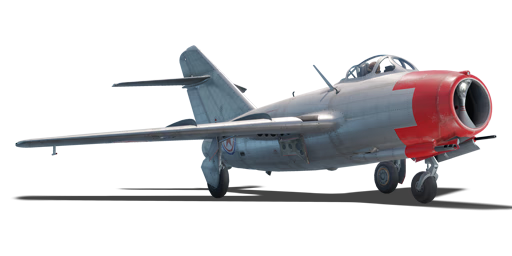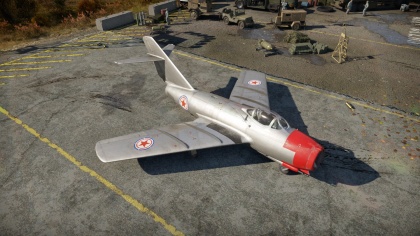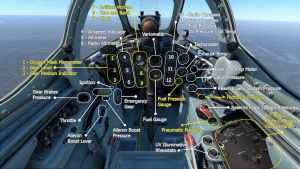Difference between revisions of "MiG-15"
(Added basic information and tables.) |
(Added basic information and tables.) |
||
| Line 1: | Line 1: | ||
{{Specs-Card|code=mig-15_ns23}} | {{Specs-Card|code=mig-15_ns23}} | ||
| − | + | {{Notice|''This page is about the aircraft '''{{PAGENAME}}'''. For other uses, see [[MiG-15_(Disambiguation)|MiG-15 (Disambiguation)]]''}} | |
== Description == | == Description == | ||
<!--''In the description, the first part needs to be about the history of and the creation and combat usage of the aircraft, as well as its key features. In the second part, tell the reader about the aircraft in the game. Insert a screenshot of the vehicle. If the novice player does not remember the vehicle by name, he will immediately understand what kind of vehicle it is talking about.''--> | <!--''In the description, the first part needs to be about the history of and the creation and combat usage of the aircraft, as well as its key features. In the second part, tell the reader about the aircraft in the game. Insert a screenshot of the vehicle. If the novice player does not remember the vehicle by name, he will immediately understand what kind of vehicle it is talking about.''--> | ||
Revision as of 22:50, 15 January 2019
Contents
| This page is about the aircraft MiG-15. For other uses, see MiG-15 (Disambiguation) |
Description
The MiG-15 is a Rank V Russian jet fighter
with a battle rating of 8.7 (AB), 8.0 (RB), and 8.3 (SB). This aircraft was introduced in Update 1.35. The main differences between this aircraft and the MiG-15 bis are weaker engine performance and NR-23 23 mm auto cannons.
General info
Flight Performance
| Characteristics | |||||||
|---|---|---|---|---|---|---|---|
| Stock | |||||||
| Max Speed (km/h at 0 m - Sea level) |
Max altitude (meters) |
Turn time (seconds) |
Rate of climb (meters/second) |
Take-off run (meters) | |||
| ABN1K2-J | RB | AB | RB | AB | RB | ||
| 1,009 | 975 | 15500 | 22.4 | 23.7 | 34.2 | 32.5 | 600 |
| Upgraded | |||||||
| Max Speed (km/h at 0 m - Sea level) |
Max altitude (meters) | Turn time (seconds) | Rate of climb (meters/second) |
Take-off run (meters) | |||
| AB | RB | AB | RB | AB | RB | ||
| 1,067 | 1,050 | 15500 | 22.8 | 22.1 | 50.8 | 42.0 | 600 |
Details
| Features | ||||
|---|---|---|---|---|
| Combat flap | Take-off flap | Landing flap | Air brakes | Arrestor gear |
| ✓ | ✓ | ✓ | X | X |
| Limits | ||||
|---|---|---|---|---|
| Wing-break speed (km/h) |
Gear limit (km/h) |
Combat flap (km/h) |
Max Static G | |
| + | - | |||
| 0 | 450 | 650 | ~20 | ~8 |
| Optimal velocities | |||
|---|---|---|---|
| Ailerons (km/h) |
Rudder (km/h) |
Elevators (km/h) |
Radiator (km/h) |
| < 600 | < 700 | < 750 | > 250 |
Survivability and armour
- 64 mm Bulletproof glass in the cockpit front
- 10 mm Steel plate in front of the pilot in the nose
- 6 mm Steel plate in pilot's seat
- 10 mm Steel plate behind the pilot's head
Armaments
Offensive armament
The MiG-15 is armed with:
- 1 x 37 mm N-37D Cannon, nose mounted (40 RPG = 40 total)
- 2 x 23 mm NS-23 Cannon, nose mounted (80 RPG = 160 total)
Suspended armament
The MiG-15 can be outfitted with the following ordinance:
- Without load
- 2 x 100 kg FAB-100 bombs (200 kg = total)
- 2 x 250 kg FAB-250M43 bombs (500 kg = total)
Usage in the battles
Top of the Soviet aviation line, the MiG-15 series is one of the most iconic jet fighter aircraft designs from after the Second World War. Earning its reputation on fame over the skies of Korea against its US contemporary, the F-86 Sabre.
The MiG-15 can be researched from its predecessor, the MiG-9/L. The MiG-15 features a powerful cannon arrangement of 2 x 23 mm and 1x 37 mm, excellent high altitude performance and is highly effective in vertical maneuvers. Unlike the MiG-9, the MiG-15 is also the first Soviet jet aircraft to feature an air brake which is extremely useful in combat situations. The jet fighter does, however, have its downsides. The lack of an “All-flying tailplane” (such as that featured on the Sabre) leads to less control over the aircraft at higher speeds approaching 1,000 kph. While the MiG is initially faster in acceleration by comparison to the Sabre, this does mean that once both aircraft are up at higher speeds, the Sabre will hold some advantages over the MiG-15. As well as this, the combination of 37 mm and 23 mm cannons creates aiming issues for pilots not familiar with their ballistic properties or velocity. Due to the size of these cannons, ammunition pools are restricted by comparison to other top tier jet aircraft.
Once pilots have learned to use the MiG-15s excellent rate of climb, acceleration and high altitude capabilities to their advantage, the downsides of the aircraft are far less significant than the positives. In the right hands, the MiG-15 can be a devastating combatant, capable of dealing with any aircraft in game swiftly. Teamwork, Squads and communication will also be beneficial when flying the MiG-15 as effective coordination between multiple pilots allow you to use this aircraft to its maximum potential. After mastering the MiG-15, you can research its improved variant, the MiG-15Bis. As the MiG-15 is essentially a slightly merged MiG-15bis, it shares much of its performance issues and abilities.
Modules
| Tier | Flight performance | Survivability | Weaponry | ||
|---|---|---|---|---|---|
| I | Fuselage Repair | Compressor | Offensive 23 mm | ||
| II | Airframe | New 23 mm Cannons | |||
| III | Wings Repair | Offensive 37 mm | BD-2-48 | ||
| IV | Engine | Cover | New 37 mm Cannons | ||
Pros and cons
Pros:
- Flaps can be deployed at high speeds
- Capable and useful air brake
- High rate of climb
- Great acceleration
- Deadly armament capable of making snapshots
Cons:
- Worse energy retention than the Sabre
- Poor turning circle
- Compression at high speeds
- Suffers from moderate stock syndrome
- Armament difficult to use (low velocities, low ammo and two different trajectories)
- Guns tend to spark a lot (the N-37 in particular)
- No G-Suit, so maintaining control is difficult when turning at high speeds
History
First taking to the air in December of 1947, the Mikoyan-Gurevich MiG-15 jet fighter aircraft came as a massive shock to the west when it appeared in the skies over Korea in the early 1950s. The swept wing fighter quickly proved itself as a capable and effective combat aircraft and forged a fearsome reputation.
The prototype I-310 was designed around the British Rolls Royce Nene engine which was purchased under license from Great Britain as the RD-45. Featuring sleek swept back wings,tricycle undercarriage and the same armament as its predecessor, the MiG-9, in the form of 2 x 23mm NS-23 cannons (Later replaced by NR-23 cannons in the MiG-15Bis model) and a single 37mm N-37D cannon all mounted centrally under the nose intake. The new aircraft was designed as an interceptor with heavy armament capable of quickly taking out bomber formations and was one of the most advanced aircraft in the world at the time.
Entering service between 1949-50, the MiG-15 made its operational combat debut in the Korean War, completely outclassing the first generation jet fighter aircraft of the UN forces such as the F-80 and F-84. The MiG’s excellent rate of climb, high-speed performance and deadly weaponry proved superior to the early jets and was only challenged by the arrival of the North American F-86 Sabre. At the time, the Sabre was the only aircraft capable of effectively combating the MiG in aerial combat and the pair became synonymous with the conflict.
From 1950, the MiG-15 was later developed into the Bis model, featuring a new engine, armament changes and minor overall improvements. However the aircraft would ultimately lead to the development of the MiG-17. The MiG-15 was also a hugely successful export aircraft, operated by many nations such as Poland, Czechoslovakia, East Germany, China, North Korea and Vietnam to name but a few. Licence built versions of the MiG-15 also existed such as the Chinese J-2, Czech S-102/3 and Polish Lim-1.
The MiG-15 is a true icon of aviation and will provide experienced pilots with an impressive top tier jet fighter when employed to its strengths, being more than a match to any other aircraft in the game.
Media
An excellent addition to the article will be video guides, as well as screenshots from the game and photos.
Read also
Sources
Paste links to sources and external resources, such as:
- topic on the official game forum;
- page on aircraft encyclopedia;
- other literature.
| USSR jet aircraft | |
|---|---|
| Bereznyak-Isayev | BI |
| Yakovlev | Yak-15 · Yak-15P · Yak-17 · Yak-23 · Yak-28B · Yak-30D · Yak-38 · Yak-38M · Yak-141 |
| Mikoyan-Gurevich | MiG-9 · MiG-9 (l) · MiG-15 · MiG-15bis · MiG-15bis ISh · MiG-17 · MiG-17AS · MiG-19PT |
| MiG-21F-13 · MiG-21PFM · MiG-21S (R-13-300) · MiG-21SMT · MiG-21bis | |
| MiG-23M · MiG-23ML · MiG-23MLD · MiG-27M · MiG-27K | |
| MiG-29 · MiG-29SMT | |
| Lavochkin | La-174 · La-15 · La-200 |
| Sukhoi | Su-9 · Su-11 |
| Su-7B · Su-7BKL · Su-7BMK · Su-17M2 · Su-17M4 · Su-22M3 | |
| Su-24M | |
| Su-25 · Su-25BM · Su-25K · Su-25T · Su-25SM3 · Su-39 | |
| Su-27 · Su-27SM | |
| Su-34 | |
| Ilyushin | IL-28 · IL-28Sh |
| Tupolev | Tu-14T |






